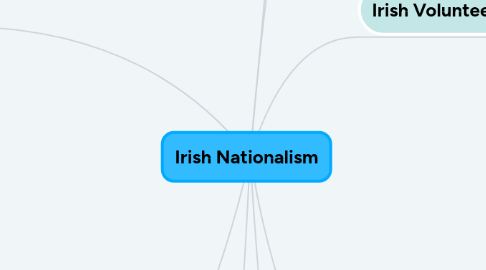
1. Irish Volunteers
1.1. Constitutional nationalism
1.2. Individuals
1.2.1. Henry Grattan
1.2.1.1. Supporter of Catholic emancipation and greater Irish rights
1.2.1.2. Protestant lawyer and MP to Dublin Parliament
1.2.1.3. 1804: Became a Westminster MP
1.3. Dates of relevance
1.3.1. 1720: Consitutional Act
1.3.2. 1872: Constitution Act
1.3.3. Feb 1872: a number of Volunteers met in Ulster to pass resolutions
1.3.4. 1781: Britain's forces in America were suffering a poor performance
1.3.5. 1783: Second Convention held in Dublin
1.4. Aims
1.4.1. Greater Irish political freedom
2. Irish Parliamentary Party
2.1. Constitutional nationalism
2.2. Individuals
2.2.1. Charles Stewart Parnell
2.2.1.1. MP for County Meath, in 1875
2.2.2. William Gladstone
2.2.2.1. Leader of Liberals
2.3. Dates of relevance
2.3.1. 1886: First Home Rule bill
2.3.2. 1892: Second Home Rule bill
2.3.3. 1912: Third Home Rule bill
2.3.4. 1882: Home Rule League changed to Irish Parliamentary party
2.3.5. 1886: From here onwards, 86/101 of the Irish MP seats regularly went to the IPP
2.3.6. 1887: The Times newspaper published letters incriminating Parnell
2.4. Aims
2.4.1. Securing Home Rule using parliamentary means
3. Home Rule League
3.1. Constitutional nationalism
3.2. Individuals
3.2.1. Isaac Butt
3.2.1.1. Protestant barrister
3.2.1.2. Believed in a reformed union
3.2.2. Joseph Gillar Biggar and John O'Connor
3.2.2.1. obstructionism
3.3. Dates of relevance
3.3.1. 1874: They won 60/101 Irish MP seats in Westminster
3.3.2. 1870: Established Home Goverment Association (HGA)
3.3.3. 1873: HGA became known as Home Rule League
3.3.4. 1880: Parnell assumed leadership
3.4. Aims
3.4.1. Home Rule
3.4.2. Gain greater autonomy in a reformed union that promotes Irish interests
4. Repeal Association
4.1. Constitutional nationalism
4.2. Individuals
4.2.1. Daniel O'Connell
4.2.1.1. He helped Catholic emancipation take place
4.2.1.1.1. Won two by elections as a Catholic candidate
4.2.1.2. Called to the bar in 1796
4.2.1.3. Founded the Catholic Association in 1823
4.3. Dates of relevance
4.3.1. Oct 1843: FAILED monster meeting (Clontarf)
4.3.2. 1840: RA set up
4.3.3. 1829: Catholic emancipation
4.3.4. Aug 1843: Monster meeting (Tara)
4.3.5. 1843: More than 40 monster meetings took place
4.4. Aims
4.4.1. Use monster meetings to force British Government into restoring an Irish Parliament
5. United Irishmen
5.1. Militant nationalism
5.2. Individuals
5.2.1. Theobald Wolfe Tone
5.2.1.1. Young Protestant barrister
5.2.1.2. Committed suicide after the failed 1798 Uprising
5.3. Dates of relevance
5.3.1. 1791: Wolfe Tone's pamphlet on Catholics published
5.3.2. 1794: Manifesto set out aims
5.3.3. 1796: Failed invasion of Bantry Bay, South Ireland
5.3.4. 1798: Failed Uprising
5.3.5. 1801: Act of Union
5.4. Aims
5.4.1. 300 equally populated Irish parliamentary constituencies
5.4.2. Every man should have the vote
6. Young Ireland
6.1. Militant nationalism
6.2. Individuals
6.2.1. Thomas Davis
6.2.1.1. Dublin Protestant Barrister
6.2.2. Charles Gavin Duffy
6.2.2.1. Catholic Journalist
6.2.2.2. Moderate, wanted to achieve aims through parliament
6.2.3. John Mitchel
6.2.3.1. Unitarian solicitor
6.2.3.2. Favoured more radical approach (peasant-led rebellion)
6.2.4. William Smith O'Brien
6.2.4.1. MP for Ennis
6.2.4.2. Moderate like Duffy
6.3. Aims
6.3.1. Complete separation from Britain
6.3.1.1. First through political persuasion and then by physical force if necessary
6.4. Dates of relevance
6.4.1. 1842: Newspaper "Nation" set up
6.4.2. 1847: Set up of Irish Confederation platform
6.4.3. 1846: Split from Repeal Association
6.4.4. May 1848: Mitchel arrested for sedition
6.4.5. 1848: Rebellion
6.4.6. July 1848: Habeas Corpus suspended
6.4.7. 1849: leaders death sentences commuted to transportation to Van Diemen's Land
6.4.8. 29 July 1848: Ballingarry violent encounter, under leadership of O'Brien
7. Irish Republican Brotherhood
7.1. Militant nationalism
7.2. Individuals
7.2.1. James Stephens
7.2.1.1. Fought alongside William Smith O'Brien at Ballingarry
7.2.1.2. Escaped to Paris amid 1848 Rebellion collapse
7.2.1.3. Learned about revolutionary underground movements in Paris- inspired
7.3. Dates of relevance
7.3.1. 1858: IRB set up by Stephens
7.3.2. 1867: Fenian Rising
7.3.3. 1867: Manchester Martyrs
7.3.3.1. William Allen, Michael Larkin and Michael O'Brien
7.3.4. 1867: Clerkenwell bombings
7.3.5. 1861: Death of Terrence McManus
7.3.6. 1856: Stephens returned to Ireland from Paris
7.4. Aims
7.4.1. Complete independence

